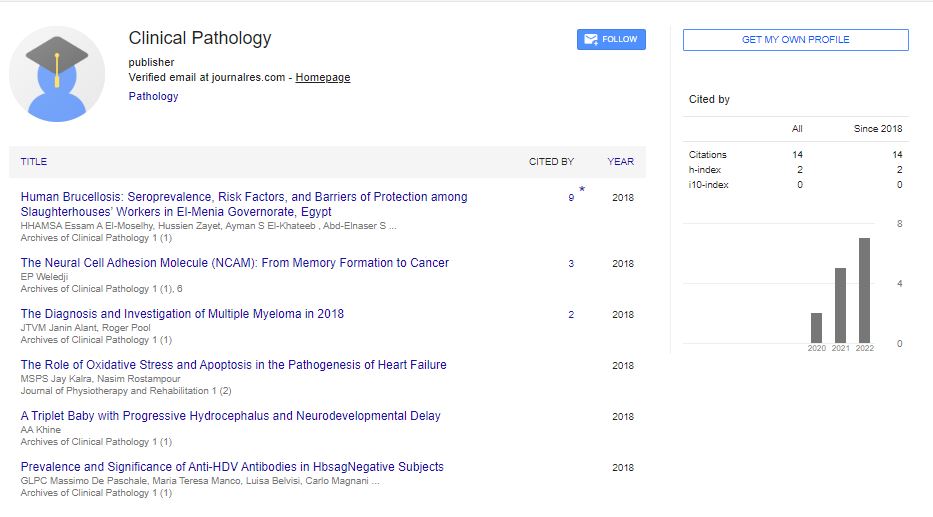Opinion Article, Arch Clin Pathol Vol: 6 Issue: 2
Understanding the Complexities of Blood Clotting
Rustem Weisel*
Department of Cell and Developmental Biology, University of Pennsylvania Perelman School of Medicine, Philadelphia, USA
*Corresponding Author: Rustem Weisel
Department of Cell and Developmental
Biology, University of Pennsylvania Perelman School of Medicine, Philadelphia,
USA
E-mail: pari.toyo@hu.jp
Received date: 28 May, 2023, Manuscript No. ACPY-23-107053
Editor assigned date: 31 May, 2023, Pre QC No. ACPY-23-107053 (PQ);
Reviewed date: 14 June, 2023, QC No. ACPY-23-107053
Revised date: 22 June, 2023, Manuscript No. ACPY-23-107053 (R);
Published date: 28 June, 2023, DOI: 2324-8955/acpy.05.03.100084
Citation: Weisel R (2023) Understanding the Complexities of Blood Clotting. Arch Clin Pathol 6:2.
Description
Blood clotting, or hemostasis, is a complex physiological process that plays a essential role in maintaining the integrity of the circulatory system. It involves a delicate balance between preventing excessive bleeding and avoiding the formation of unwanted clots. A thorough understanding of the mechanisms underlying blood clotting is essential for diagnosing and managing various bleeding and clotting disorders. This study provides an overview of the intricate process of blood clotting, highlighting its key components and regulatory mechanisms.
The process of blood clotting involves a series of interconnected steps that occur in response to vessel injury. The main components involved in blood clotting are platelets, coagulation factors, and endothelial cells lining the blood vessels. Platelets, small cellular fragments, are the first responders to vessel injury. They adhere to the site of injury, aggregate together, and release substances that promote further activation of platelets and initiation of clotting. Coagulation factors, a group of proteins present in the blood plasma, are responsible for the formation of a stable blood clot. They interact in a cascade-like manner, with each step amplifying the next, ultimately leading to the conversion of a soluble plasma protein called fibrinogen into insoluble fibrin strands. Fibrin strands form a meshwork that entraps platelets and other blood cells, creating a stable blood clot.
The coagulation cascade can be divided into two pathways: the intrinsic pathway and the extrinsic pathway. The intrinsic pathway is triggered by contact between blood and an injured vessel wall, while the extrinsic pathway is initiated by the release of tissue factor from damaged tissues. Both pathways converge on a common pathway that leads to the activation of a key coagulation factor called thrombin. Thrombin has multiple functions, including the conversion of fibrinogen to fibrin, activation of platelets, and amplification of the coagulation cascade. Regulation of blood clotting is essential to prevent the formation of clots in healthy blood vessels and to limit clot growth to the site of injury. Several natural anticoagulant mechanisms are in place to control the clotting process. Ant thrombin, a protein in the blood plasma, inhibits the activity of several coagulation factors, including thrombin. Protein C and protein S form a complex that inactivates another key coagulation factor called factor Va. Tissue Factor Pathway Inhibitor (TFPI) blocks the initiation of the coagulation cascade by inhibiting the tissue factor.
Disruptions in the delicate balance of blood clotting can lead to bleeding disorders or thrombotic disorders. Bleeding disorders, such as hemophilia and von Willebrand disease, result from deficiencies or dysfunction of specific coagulation factors or platelets. These disorders can manifest as prolonged bleeding after injuries or spontaneous bleeding. Thrombotic disorders, on the other hand, involve excessive or inappropriate clot formation. Conditions like deep vein thrombosis, pulmonary embolism, and stroke are examples of thrombotic disorders.
Understanding the complexities of blood clotting is essential for the diagnosis and management of these bleeding and clotting disorders. Laboratory tests, such as Prothrombin Time (PT), Activated Partial Thromboplastin Time (aPTT), and platelet function tests, are commonly used to evaluate the integrity and function of the clotting system. These tests help identify specific deficiencies or abnormalities in the clotting process, guiding appropriate treatment strategies.
In the field of medicine, an in-depth understanding of blood clotting is vital for various specialties. Surgeons must consider clotting factors and platelet function when performing procedures to minimize bleeding risks. Hematologists specialize in the diagnosis and management of bleeding and clotting disorders, working closely with other healthcare professionals to provide optimal patient care. Pharmacologists and pharmaceutical companies develop anticoagulant medications to prevent or treat thrombotic events.
In conclusion, the process of blood clotting is a highly regulated and intricate mechanism that maintains the balance between hemostasis and prevention of excessive clot formation. Understanding the complexities of blood clotting is essential for diagnosing and managing bleeding and clotting disorders. Ongoing research in this field continues to improve our understanding of blood clotting and develop novel therapies for individuals with bleeding and thrombotic disorders.
 Spanish
Spanish  Chinese
Chinese  Russian
Russian  German
German  French
French  Japanese
Japanese  Portuguese
Portuguese  Hindi
Hindi 